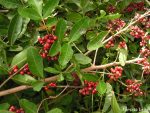 Also called Christmasberry tree and Florida holly, this evergreen shrub or small tree is a member of the cashew family, Anacardiaceae, that also includes poison ivy, sumac, and smoke tree. It is native to Argentina, Paraguay, and Brazil but was introduced to the US by the mid 1800s as an ornamental and has become invasive in Florida, Texas, California, Hawaii, and Puerto Rico. Plants can become established in both disturbed and undisturbed sites but do so more readily in the former. They invade both aquatic and terrestrial habitats including old fields, forests, hammocks, ditches, and wetlands, where they produce a dense canopy that shades out native vegetation. Rapid growth and a high germination rate have led to the rapid spread of the plant. Control measures are thwarted by the production of sprouts by the roots of cut trees and the desire of people to grow the plant for its beautiful berries and appearance of the tree. The trees tolerate full sun to light shade, a wide variety of soils, drought, dessert atmosphere, seaside conditions, dust, and smoke but not prolonged freezing or strong winds.
Also called Christmasberry tree and Florida holly, this evergreen shrub or small tree is a member of the cashew family, Anacardiaceae, that also includes poison ivy, sumac, and smoke tree. It is native to Argentina, Paraguay, and Brazil but was introduced to the US by the mid 1800s as an ornamental and has become invasive in Florida, Texas, California, Hawaii, and Puerto Rico. Plants can become established in both disturbed and undisturbed sites but do so more readily in the former. They invade both aquatic and terrestrial habitats including old fields, forests, hammocks, ditches, and wetlands, where they produce a dense canopy that shades out native vegetation. Rapid growth and a high germination rate have led to the rapid spread of the plant. Control measures are thwarted by the production of sprouts by the roots of cut trees and the desire of people to grow the plant for its beautiful berries and appearance of the tree. The trees tolerate full sun to light shade, a wide variety of soils, drought, dessert atmosphere, seaside conditions, dust, and smoke but not prolonged freezing or strong winds.
Description: Plants grow up to 30’ from a shallow root system and have upright or sprawling branches and pinnately compound leaves with 5-15 ellipitical, finely toothed leaflets 1-2” long. Small white male and female flowers are produced in 2-3” long axillary clusters on different plants from summer to fall. Female plants produce clusters of small one-seeded fleshy berry-like fruits that are glossy and green at first but ripen to bright red. The berries are very attractive and used in flower arrangements especially at Christmas.
Control: Plants can be mechanical removed but care must be taken to eliminate all the root because roots as small as ¼” in diameter can resprout and produce a new plant. Fire is not considered a good management technique because of the potential of resprouting by small surviving roots. The herbicides triclopyr and glyphosate can be applied to the foliage, or used in basal bark and stump treatments. The root absorbed herbicides bromacil, diuron, and hexazinone are effective but are slow acting and have the most residual activity.